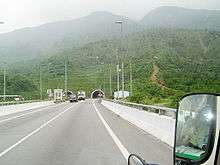Hải Vân Tunnel
The Hải Vân Tunnel, the longest tunnel in Southeast Asia at 6.28 km (3.90 mi), lies on Highway 1 between the two cities of Da Nang and Huế in central Vietnam.[1]
 Hải Vân bridge leads to the Tunnel | |
| Overview | |
|---|---|
| Location | Between Huế and Đà Nẵng |
| Route | Highway 1 |
| Operation | |
| Work begun | 2000 |
| Opened | 2005 |
| Character | 1 tunnel |
| Technical | |
| Length | 6,280 m (20,600 ft) |
| No. of lanes | 2 |
| Operating speed | 70 km/h |
History
The Hải Vân Pass has long been recognised as a major bottleneck. The concept of a tunnel to bypass the long route over the top had long been sought.
Planning and design
Route planning and design work started in January 1998 by a joint venture between Nippon Koei Company Limited Japan and Louis Berger International Inc., USA with the Vietnamese Transport Engineering Design Incorporated (TEDI) providing consultation on the project.
Construction
The tunnel was split into two segments, a southern and a northern section. The southern section (4 km (2.49 mi)) was constructed by a Vietnam–Japan joint venture between the Japanese Hazama Corporation and their Vietnamese partners, Cienco 6. The 2 km (1.24 mi) northern section was constructed by a joint venture between Korea's Dong Ah construction company and Vietnam's Song Da Construction Corporation.[2]
The tunnel officially opened on June 5, 2005.
The main tunnel is 11.9 m (39.0 ft) wide. A second tunnel running alongside the main tunnel is currently used for maintenance and emergencies but it is planned to expand this at a later date as traffic increases. It is connected to the main tunnel by 15 cross-tunnels. The tunnels have lighting, fire alarms, communication, water supply and treatment, ventilation fans, and radio broadcast systems.
The tunnel subsequently has received an award for quality by the American Construction Management Association.[3]
Operation
Currently the single tunnel has one lane of traffic in each direction. As no overtaking is possible this can result in minor delays if motorists are stuck behind slow moving traffic. A toll of VND25,000 is payable for cars/mini buses.
Motorcycles, cycles and pedestrians are not allowed in the tunnel but a new shuttle service began in November 2006. This shuttle service operates around the clock with a reduced overnight service and a daytime fare of VND25,000 or VND30,000 per motorcycle, VND15,000 per bicycle, and VND10,000 per person.
A small waiting area has been established at each end of the tunnel where visitors can take photographs and watch a documentary about the making of the tunnel.
The tunnel reduces the distance between Da Nang and Huế by 20 km (12 mi) and saves between 30 minutes and an hour on traveling times over the old Hải Vân Pass route.
References
- "Vietnam's major road tunnel inaugurated". Xinhua News Agency. August 21, 2017. Retrieved September 10, 2017.
- "Hai Van Tunnel Construction Project". Japan International Cooperation Agency. August 21, 2017. Retrieved September 10, 2017.
- Di Michael A. Giovine (2009). The Heritage-scape: UNESCO, World Heritage, and Tourism. Lexington Books. p. 484. ISBN 978-0-7391-1435-3.
External links
- Construction Site Report
- Google Place
- This Da Nang information section has all the important travel details you’d need for a well-planned vacation in this coastal city du lich da nang